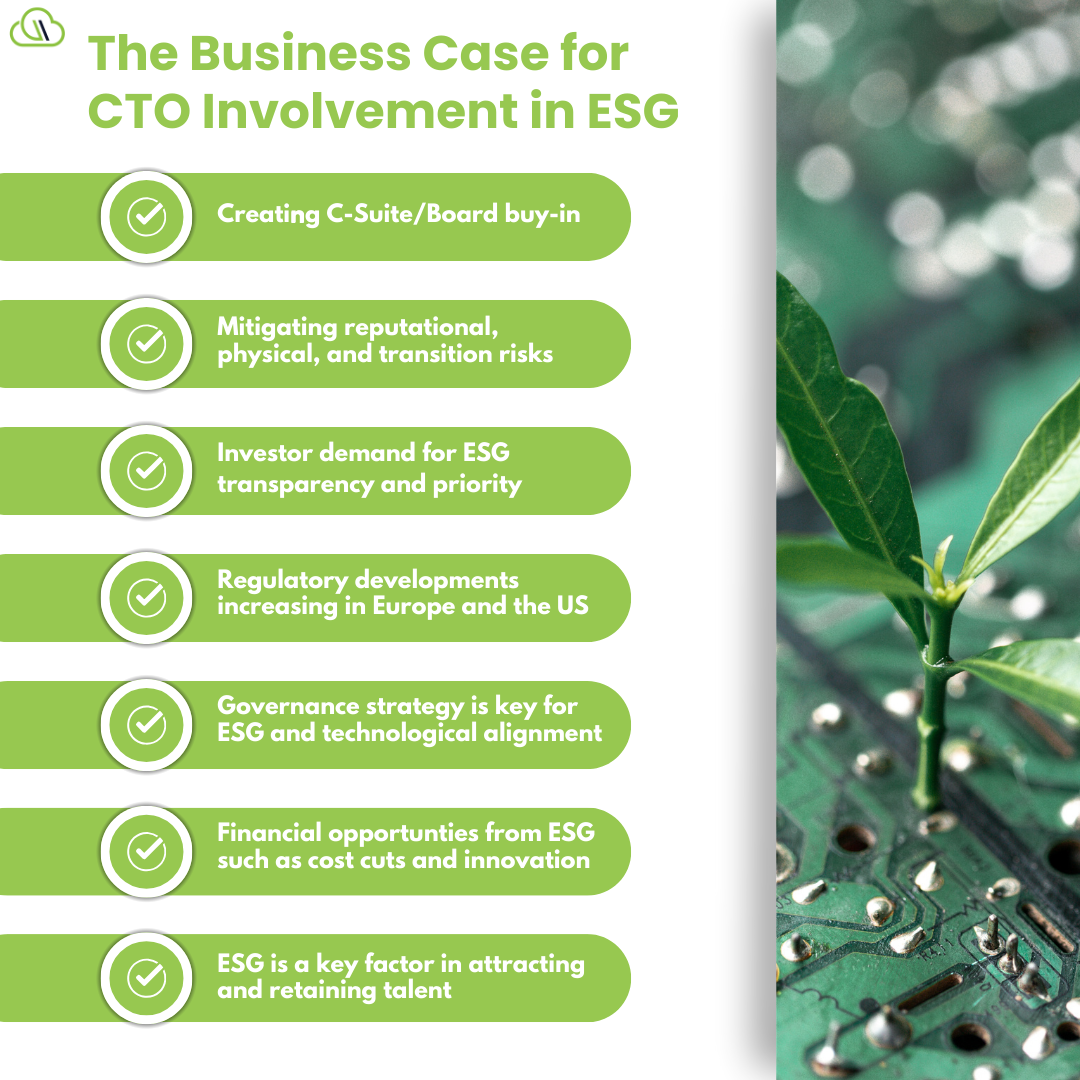Why should Chief Technology Officers engage with ESG?
An effective Chief Technology Officer (CTO) aims to build and align a technology strategy that supports their business’s vision and growth while innovating through emerging technologies to create a competitive advantage. Savvy CTOs understand that aligning the organization’s ESG strategy with the data that drives financial and strategic decisions is essential for success in the modern landscape.
To support their organization’s ESG journey, the CTO will need to collaborate with key stakeholders across functions such as Corporate Strategy, Risk and Compliance, Operations, Marketing, and more. Ensuring data is facilitated between departments is crucial for decision-making. The CTO is uniquely positioned to guide the flow of data throughout the organization and ensure that all business areas have the information they need to support ESG initiatives alongside usual business activities.
The Business Case for ESG

The Role of the CTO in the ESG Journey
Data is the cornerstone of any ESG strategy, as good data enables an organization to accurately calculate its carbon footprint and comply with regulations and reporting requirements. Complete ESG data also enables an organization to understand and mitigate ESG-related risks, identify areas for innovation or process optimization, and ensure investor confidence.
ESG is increasingly becoming a major factor for investors, with 89% of investors considering ESG when making their investment decisions. Investors are looking for reliable, transparent ESG data when investing capital. A CTO will need to understand the data landscape, facilitate the movement of data to departments that utilize the information for decision-making, and devise a technological strategy to organize and analyze ESG data.
Choosing an ESG Platform
While many organizations began by tracking ESG data in an Excel spreadsheet, choosing the right ESG data management platform is important for getting the most insight out of your ESG data. The CTO should begin by defining data goals that support the organization’s overarching ESG objectives. For example, if an organization needs to track transportation emissions but has no commercial building emissions to track, this may inform the platform choice and implementation process.
Ranking the features that your organization values from a data management platform is a helpful way to narrow down the search. Evaluate which features are “must haves” and which are “nice to haves”, so you can compare this list to platform capabilities.
Finding the right implementation partner is another consideration. The size, goals, and timelines of your organization may influence whether you choose a smaller boutique firm or a larger enterprise partner. For multinational companies, a bigger partner with more resources may be the best choice. Organizations that are looking for highly customized implementations may look for a specialized partner that has both ESG and technological expertise. A small boutique firm may be a good option for businesses that only need basic functionality or have a smaller budget.
When developing tools or looking for a partnership, consider the following criteria:
1. Ability to analyze data from a wide range of assets, sources, and scopes.
2. Supports advanced data analytics, forward-looking scenarios, trend identification, and emissions reduction insights.
3. Monitors or complies with emerging ESG standards and reporting frameworks.
4. Ease of transferring data into/out of the platform.
5. Time and cost of implementation and training.
Navigating Data Challenges
Obtaining and managing ESG data and reporting is still a challenge for most organizations. A lack of consistency in reporting guidelines, impact measurement, and the general novelty of ESG data collection makes it difficult to acquire a complete, accurate emissions dataset. The process of collecting, consolidating, and reporting ESG data can be complex and costly, but the CTO can add value in overcoming these challenges in many ways:
- Leverage advanced data and analytics platforms, such as Salesforce Net Zero Cloud, to house all ESG data in a single source of truth.
- Scrutinize sourcing of ESG data, including supply chain data.
- Implement governance and stewardship levers for internal and external data.
- Engage with partners, suppliers, regulators, and peers.
- Increase the accessibility of data analytics and insights for the C-suite.
- Ensure successful digitalization of documentation to support the ESG portfolio management, the classification of products, and workflow information.
CTOs should first look to develop data benchmarks and choose a tool or software partner to assist them with overcoming the previously mentioned pain points. Choosing a platform that can run advanced analytics on a broad range of data will be key to overcoming ESG data challenges.
Centralizing data is a common pain point, as it is a time-intensive process. As your organization begins to load data into your ESG platform, prioritize data sets based on reporting requirements or other time-sensitive needs. Automate the integration of your high-priority datasets and identify resources to manage inputting the lower-priority data sets until all datasets are automated.
Avoiding data silos is important when collecting and synthesizing ESG data, as this data will be sourced from many different business areas that may not be directly communicating. As the CTO, it is important to facilitate data across the organization to avoid data silos. For more in-depth information on breaking down data silos to facilitate collaboration, check out this article.
Summary
ESG factors are important not only for those working in sustainability directly but for the health of the organization overall. The CTO plays an important role in data collection, communication, and governance. When leveraged correctly, technology can be a catalyst for any organization to lead their industry in ESG and attract both internal talent and investor interest. Any CTO in the modern age should learn to utilize their position to facilitate technological support for ESG initiatives and the safe communication of data across departments.
